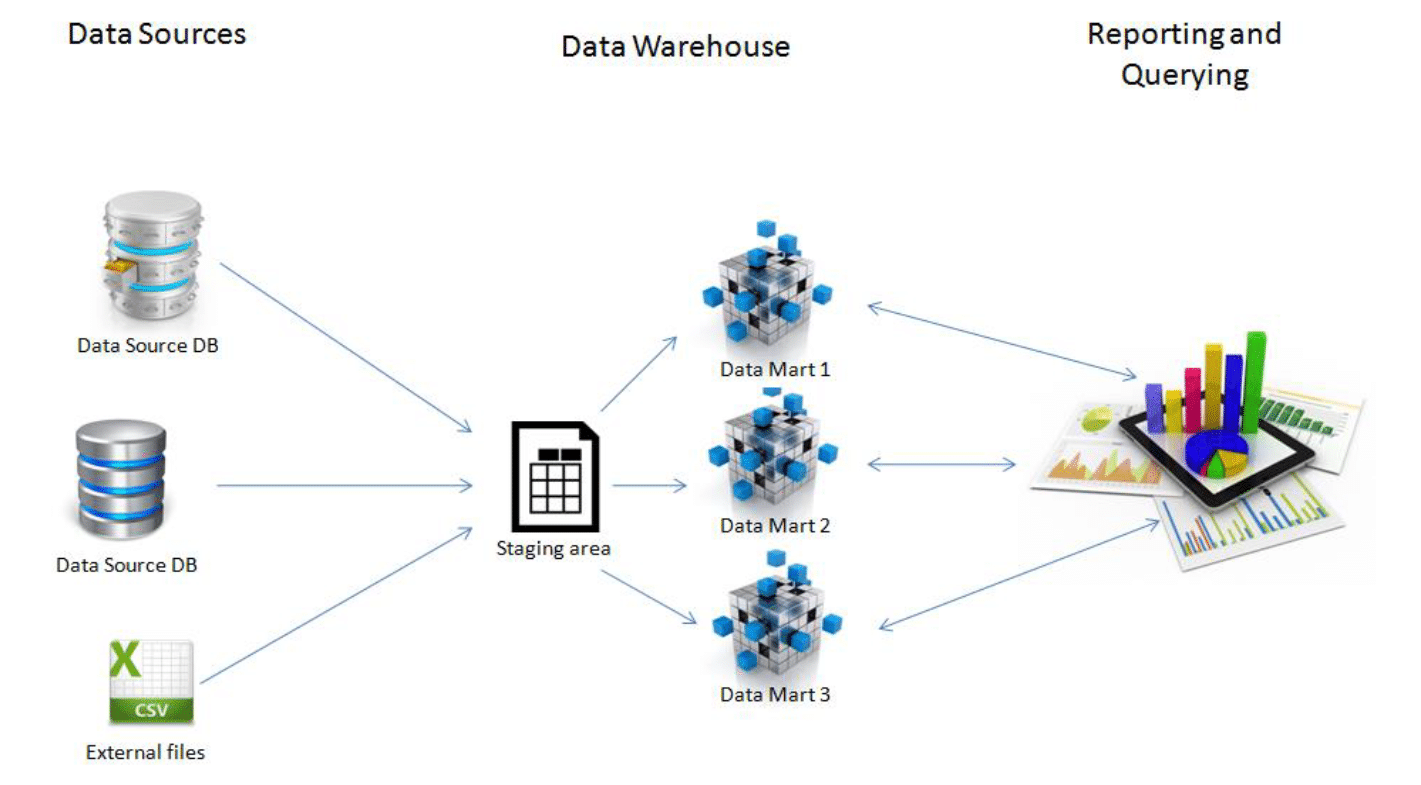What’s the Deal with Dimensional Modeling?
Let’s talk about Dimensional Modeling (DM) – the superhero of data storage techniques for data warehouses. You know what makes it special? Its laser focus on getting data out fast, unlike those traditional systems that spend all their time worrying about putting data in.
Think about it: while relational models obsess over adding, updating, and deleting data (like that one colleague who can’t stop reorganizing their desk), dimensional models say, “Let’s make it super easy to grab what we need!” It’s like organizing your kitchen – sure, you could alphabetize everything, but wouldn’t you rather group stuff based on how you actually use it?
Elements of Dimensional Data Model
Facts: The Real MVPs
Facts are the numbers that matter – the cold, hard metrics from your business processes. Take quarterly sales numbers – that’s your fact right there. No fluff, just straight-up measurements that tell you how things are going.
Dimensions: The Context Champions
Dimensions are like the storytellers of your data. They give you the who, what, and where of every fact. When looking at those quarterly sales numbers:
- Who? Customer Names (Bob from accounting ain’t just a number)
- Where? Location (Because selling ice cream in Alaska hits different)
- What? Product Name (You gotta know what’s flying off the shelves)
Attributes: The Detail Devils
Attributes are like the nosy neighbors of dimensions – they know everything about everyone. Take your Location dimension:
- State (The big picture)
- Country (The bigger picture)
- Zip code (For those who need to get specific)
These little details let you slice and dice your facts however you want. Need to know ice cream sales in tropical zip codes? Attributes got your back.
Fact Tables: The Heavy Lifters
Oh boy, fact tables – these are where the magic happens! They’re like the busy intersection of your data warehouse, where all roads meet. Here’s what they pack:
- Measurements (The actual numbers you care about)
- Foreign keys (The connections to your dimension tables)
- Usually skinny but tall (Like that one friend who never skips cardio)
Characteristics of Fact Tables
- They’re all about those numbers – if you’re counting widgets sold, this is where that “20” lives
- They’re connected to dimension tables through foreign keys (like a really organized family tree)
- They keep it simple with few columns (minimalism at its finest)
- They compensate with lots of rows (making up for their skinny structure with height)
Dimension Tables: The Detail Masters
These tables are like the Wikipedia of your data model – full of descriptions and details about your facts. They:
- Join to fact tables through foreign keys
- Live their best denormalized life
- Never met an attribute they didn’t like
- Can handle hierarchical relationships like a pro
Additive, Semi-Additive, and Non-Additive Facts
Let’s break down these facts (pun definitely intended). Your numeric measures fall into three categories, like developers at a hackathon – the ones who can do everything, the ones who need supervision, and the ones who shouldn’t touch the production code.
Fully additive facts are your rockstars – they’ll sum up across any dimension without throwing a fit. Semi-additive facts? They’re like that colleague who works great with some team members but not others. Take balance amounts – they’ll add up across dimensions except time (cause you cant just add up your bank balance across months; thats not how money works).
Non-additive facts are the rebels – ratios and percentages that refuse to play by the rules. Pro tip: store the components that make up these non-additive measures. Sum those up first, then calculate the final ratio. Its like building your UI before your API is ready – sometimes you gotta work backwards.
Steps of Dimensional Modelling
Listen up, data warriors’ – here’s your battle plan for dimensional modeling success:
- Business Process Identification
- Granularity (level of detail) Identification
- Dimension Identification
- Facts
- Build Star
Your model should answer the Why, How much, When/Where/Who and What about your business process (just like those pesky status update meetings).
Business Process Identification
This step is like picking which programming language to use – get it wrong, and you’ll be posting on Stack Overflow till retirement. Pick processes like Marketing, Sales, HR – whatever keeps the lights on in your organization.
Pro tip: The quality of data available matters more than your CTO’s preference’s. One bad dataset can crash your entire warehouse faster than a junior dev with production access.
Identify the Granularity
Granularity is all about detail levels. should you track sales daily, hourly, or by microsecond? (spoiler: probably not microsecond unless your selling crypto).
You need to answer questions like:
- Do we need ALL products or just the ones making money. (Your choice might affect your next performance review)
- Do we track product sales monthly, weekly, daily or hourly. (Depends on how many reports your executives demand)
- How much storage can we afford. (Cloud bills ain’t gonna pay themselves)
Example time (cause who doesnt love examples): Your CEO wants daily sales data for specific products by location. Your granularity is “product sales information by location by day.” Simple as that – no need to overcomplicate it like a 20-layer microservice architecture.
Identify the Dimensions
Dimensions are the nouns in your data story – date, store, inventory. Their like the variables in your code, except they actually make sense to business users.
Example: When your CEO wants sales data:
- Dimensions: Product, Location, Time (the holy trinity of retail analytics)
- Attributes: Product gets stuff like Name, Type, Specs
- Hierarchies: Location breaks down from Country to Street Address (like inheritance, but useful)
Identify the Facts
Facts are like your production metrics – they tell the real story when your manager asks “what have you been doing all day?” When your CEO wants sales data, your fact is simple: Sum of Sales by product by location by time. No need to overcomplicate it like a microservices architecture designed by a committee.
Build Schema
Time to implement your dimensional model! Think of schemas as your database’s floor plan – you wouldn’t build a house without one (though some developers might try).
Star Schema
Star schema is like that one senior developer who keeps things simple:
- Fact table in the middle (like that one person who actually knows how everything works)
- Dimension tables radiating outward (like junior devs asking for help)
- Fact tables stay normalized (because someone has to maintain standards)
- Dimension tables live their best denormalized life (sometimes you gotta break the rules)
Snowflake Schema
Snowflake schema is what happens when the architecture team gets too much coffee:
- Its an extended star schema (because regular stars weren’t fancy enough)
- Each dimension is normalized (perfectionism at its finest)
- Connected to more dimension tables (like a LinkedIn network gone wild)
Rules for Dimensional Modelling
Listen up, data architects – here’s your commandments:
- Load atomic data into dimensional structures (no sneaking in aggregates)
- Build models around business processes (not your personal preference’s)
- Every fact table needs a date dimension (time waits for no data)
- Facts in one table must be at same grain (mixing granularities is like mixing tabs and spaces)
- Store report labels in dimension tables (your future self will thank you)
- Use surrogate keys (natural keys are so last century)
- Balance requirements with reality (unlike your project deadlines)
Benefits of Dimensional Modeling
- Standardization across business areas (like coding standards, but people actually follow them)
- Dimension tables remember history (unlike git commits that say “fixed stuff”)
- Add new dimensions without breaking everything (try that with your microservices)
- Data retrieval that actually works (faster than finding matching socks)
- Business folks actually understand it (a miracle!)
Degenerate Dimension Tables
These are the rebels of the dimension world – they exist in the fact table but don’t have their own dimension table. Its like having a function without a separate class – sometimes it just makes sense.
Think order numbers, ticket numbers, or transaction IDs. They’re useful for grouping related facts together, like tying all items in a shopping cart to one order number (because nobody wants to debug mismatched orders).
Junk Dimension Tables
Junk dimensions are like that “misc” folder on your desktop – they combine multiple low-cardinality flags into one dimension. Example: car color and body style. Sure, you could make separate dimensions, but sometimes you gotta keep it simple.
Limitations of Dimensional Data Modelling
Nothing’s perfect (except maybe your managers expectations):
- You need domain knowledge (googling only gets you so far)
- Loading data is complicated (like explaining agile to traditional project managers)
- Changes are painful (like updating dependencies in a legacy project)
The Bottom Line: Dimensional Modeling Decoded
After diving deep into the rabbit hole of dimensional modeling (and possibly losing a few brain cells along the way), lets wrap this up with some hard-earned wisdom.
Dimensional modeling isn’t rocket science – its data science (which is arguably more complicated because at least rockets follow physics). What we’ve learned through this journey:
The Good Stuff
- Your data finally makes sense to business users (a miracle right up there with developers writing documentation)
- Queries run faster than your morning coffee break
- Changes won’t break everything (unlike that time you updated Node.js)
- History tracking that actually works (unlike your git commit messages)
The Not-So-Good Stuff
- You need domain knowledge (Stack Overflow can’t save you here)
- Loading data is trickier than explaining why the production server is down
- Changes require actual planning (yes, planning – scary word, i know)
Real Talk
Dimensional modeling is like building LEGO® sets – start with the basic blocks (facts and dimensions), follow the instructions (modeling rules), and try not to step on any pieces barefoot (data quality issues). Its not perfect, but neither is your code, and that hasn’t stopped you yet.
Remember:
- Facts are your measurements (the numbers that keep executives happy)
- Dimensions give context (so you know why those numbers make executives unhappy)
- Star schemas are your friend (unlike that colleague who keeps breaking the build)
- Snowflake schemas are for overachievers (you know who you are)
Moving Forward
Data warehousing without dimensional modeling is like coding without Stack Overflow – technically possible, but why would you do that to yourself? The techniques we’ve covered here will save you countless hours of debugging weird queries and explaining confusing reports.
Before you run off to reorganize your entire data warehouse:
- Start small (nobody ever said “this project failed because we didn’t make it complicated enough”)
- Test thoroughly (pretend its production code)
- Document everything (future you will be slightly less annoyed)
And remember – if someone tells you dimensional modeling is outdated, they probably think Excel is a database. Keep calm and model on!

